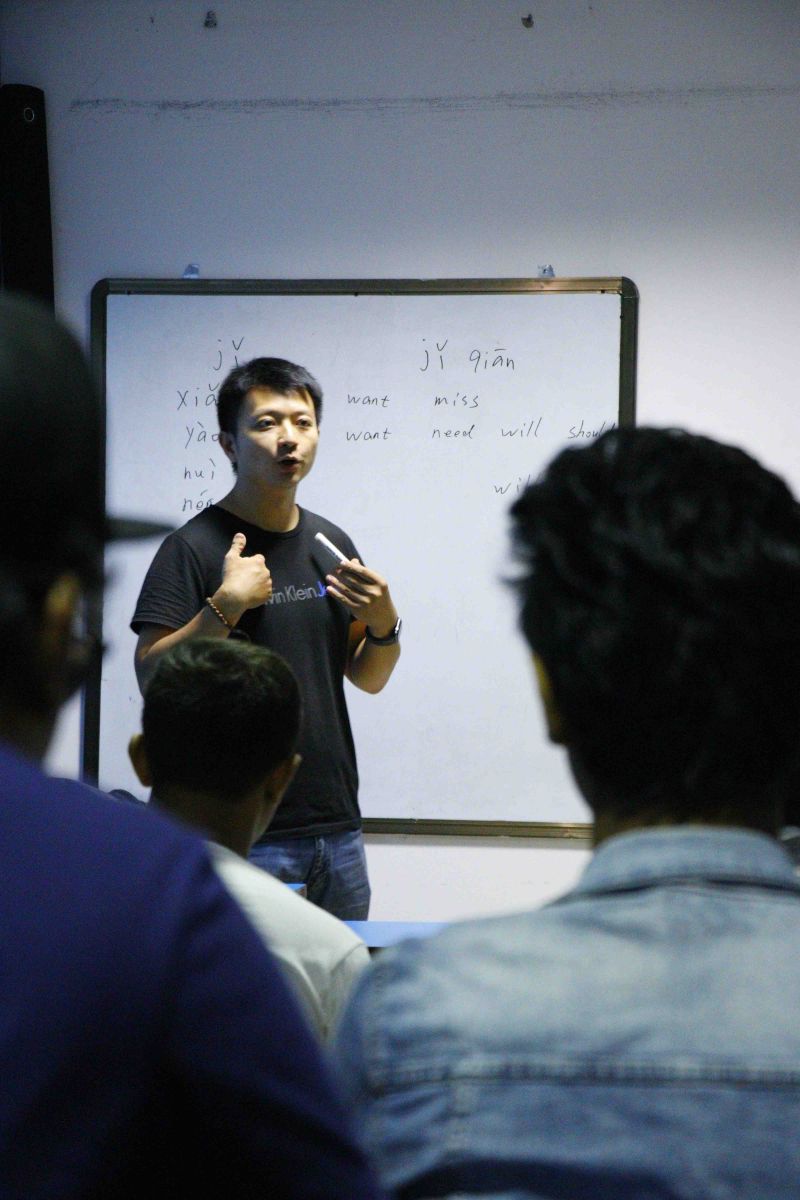The Dynamic Lure of Learning Chinese
Just as English is a global language today, Chinese, too, is surely on its way to becoming one.
It is not an exaggeration to say that China holds the center stage world-wide, and Chinese is gaining special attention as a must-to-be-learned language. This is especially true for its immediate neighbor, Nepal.
As Wang lei, a second-year postgraduate student in Teaching Chinese as a Second Language (TCSL in short), walked into Class 3 C of Triyog High School, a girl bumped into her arms, looked up into her eyes, and began to belt out the Chinese nursery rhyme “Liang Zhi Lao Hu”, which refers to two tigers in English. “This is her best-loved song,” Wang smiled and said. After the girl finished the entire rhyme, Wang got down to placing all her teaching stuff on a 50-cm desk—a laptop for video play, a sound box for brighter voice, a bag of chopsticks for role-play games. As soon as she opened the laptop and ceased at the video playing page, her students, especially the boys, flooded into the front of the classroom, throwing back their heads and batting their eyes. “This video is about the use of chopsticks, subtitled in both English and Chinese. All my students are so allured by such videos that they sit with both hands on the lap, instead of hanging around the classroom or grabbing some water to drink,” said Wang.
Wang alone is at the helm of Chinese language teaching in Triyog, a private high school in Nepal stepping into its third year of teaching Chinese for primary level students. Besides chopsticks, Wang also talks about the diversified Chinese cultural phenomenon. For instance, Sichuanese Opera, a type of Chinese opera originating in China’s Sichuan province around 1700, and Chinese Dragon Boat Festival, a traditional holiday occurring near the summer solstice. “When I was being selected as a TCSL volunteer, I was required to show at least one talent relevant with Chinese culture, for example calligraphy, a visual art related to writing, and folk dances.” Wang said. In 2017, more than sixty Chinese language teaching volunteers successfully applied and were selected by the Confucius Institute Headquarter. According to Wang, promoting Chinese culture through Chinese language is the essential task.
“In the world of globalization, China is now becoming a global lingua franca, besides English. If my students can know some Chinese, they may not have too much difficulty when going out of Nepal,” said teacher Gita Prajapati. The school introduced Chinese language lessons for students from Grade 1 to Grade 5 in 2014. Apparently, the school’s director was once cheated by a Nepali native proposing to teach Chinese—what the school had been wanting was Mandarin-teaching, but the students were taught Cantonese, which is not commonly spoken in China. Taking that as an object lesson, he deemed Confucius Institute Headquarter (Hanban), a public institution affiliated with the Chinese Ministry of Education and committed to providing Chinese language and cultural teaching resources and services worldwide, as the one and only option.
 |
C-center: for those who fiercely aspire to do business in China
C-center Nepal, a profitable Chinese language learning institution established in 2014, targets those who fiercely aspire to do business in China, or with Chinese people as clients, including business school students, employees of travel agencies, hotels, and even banks, as well as middle-aged folks hungering for any career potential in China. Walking around Islington College, one of the colleges cooperating with C-center, at 8:50 a.m. on weekdays, fifteen or so college students could be observed to be chatting in Chinese or reading their textbooks. A few office workers wearing suits and ties would also join them.
“In one word, my institution is to provide specific support for making-money-in-China-oriented language skills and information-obtaining skills,” said Wu Hao, the founder of C-center. Since China and Nepal signed the Belt and Road Initiative (BRI in short) in May 2017, Wu can evidently sense that the eagerness of Nepali people to learn Chinese is rocketing. ”It is not long ago that nearly one hundred students registered for my Chinese class, but only ten of them did come,” Wu recalled, with a rueful smile. Now, he has students rushing to him to learn Chinese, and crying that their neighbor managed to build a five-story brand-new apartment, all attributing to grasping Chinese language skills. “In my future, my expansion of C-center will keep pace with BRI,” said Wu, referring to the business potentials brought about by BRI.
Till now, C-center has successfully trained more than two thousand Nepali students. One of Wu’s clients is the best trek agency in Nepal. As the company strategically resolved to expand into the Chinese market, it sought help from C-center. It takes Wu and his team over two months to design specified Chinese language course for trekking guides. “While teaching the guides Chinese, I am actually connecting the top professional service resources to my Chinese compatriots!” Wu concluded.
Wu Hao has just expanded the scale of his resident teaching squad into four. Wang Ming Li is a retired English teacher from Henan University, who obtained a CLS teaching certificate two years ago. In the August of 2017, he brought his wife to Nepal, initially captivated by the country’s Buddhism mystique. Seizing this as an opportunity, Wu invited the couple to join him and teach Chinese. “I was quite impressed by his dedication of promoting Chinese culture through teaching Chinese—three classes a day, five days a week,” Wang said. Routinely, the squad holds informal teaching seminars every day, during which they share teaching experiences and deliberate about how to teach Nepali students better. As a Business English teacher for more than fifteen years, Wang claimed that he had a distinct advantage in English, and exclaimed, “In the meetings, I would always point out Wu’s incorrect pronunciation!”










